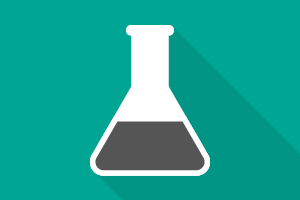Classroom Resources: States of Matter
Filter by:
26 – 41 of 41 Classroom Resources
-

Chemical Change, Phase Changes, Combustion, Observations | Elementary School, Middle School
Demonstration: The Jumping Flame Mark as Favorite (5 Favorites)
In this demonstration, students will observe that the vapor of an extinguished candle flame is ignitable.
-

Intermolecular Forces, Physical Properties, Melting Point, Boiling Point | High School, Middle School
Activity: Simulation Activity: Exploring Intermolecular Forces with Odyssey Mark as Favorite (4 Favorites)
In this simulation, students will learn about the different intermolecular forces. They will use the simulation to see how molecules in various species interact with one another.
-

Heating Curve, Phase Changes, Intermolecular Forces, Freezing Point, Melting Point, Boiling Point, Heat of Fusion, Heat of Vaporization , Molecular Motion, Temperature, Heat, Specific Heat | High School, Middle School
Activity: Simulation Activity: Heating Curve of Water Mark as Favorite (88 Favorites)
In this simulation, students will investigate qualitatively and quantitatively what happens as water changes states.
-

Freezing Point, Melting Point, Phase Changes, Acids & Bases, Physical Change | Middle School
Lesson Plan: Stearic Acid Mark as Favorite (2 Favorites)
In this lesson, students investigate how stearic acid undergoes a phase change from solid to liquid and back from liquid to solid. Temperature readings will be collected at one-minute intervals once the acid melts, the heat escapes, and the acid cools. Students are introduced to the idea that energy loss does not always result in a continuous temperature drop.
-

Mixtures, Separating Mixtures, Solubility, Physical Change, Phase Changes | Middle School
Lab: A Solution to Your Mix-up Mark as Favorite (4 Favorites)
In this lab, students will perform a step by step process of mixing and separating substances based on their states and solubility in order to solve a problem.
-

Pressure, Gas Laws, Kinetic Molecular Theory, Temperature, Volume, Molecular Motion, Intermolecular Forces | High School, Middle School
Lab: Gas Pressure Mark as Favorite (39 Favorites)
In this lab, students will understand what causes pressure in a container and the variables that affect pressure (volume, temperature, number of moles) by mimicking molecular motion of gases.
-

Kinetic Molecular Theory, Pressure, Gas Laws, Volume, Temperature, SI Units, Molecular Motion | High School, Middle School
Activity: Simulation Activity: Gas Law Variables Mark as Favorite (4 Favorites)
In this simulation, students investigate variables of a gas. From the computer models, they can see how pressure, temperature, and volume effect gas behavior.
-

Phase Changes, Sublimation, Physical Change, Density, Observations, Temperature | Middle School
Lesson Plan: Dry Ice Mark as Favorite (0 Favorites)
In this lesson, students will investigate how dry ice undergoes a phase change from solid to gas, skipping the liquid phase under normal temperature and pressure.
-

Sublimation, Density, Observations | High School, Middle School
Lab: Dry Ice (High School) Mark as Favorite (30 Favorites)
In this lab, students perform several small experiments using dry ice and record their observations.
-

Phase Changes, Physical Change, Observations, Temperature | Elementary School, Middle School
Lab: Condensation Mark as Favorite (2 Favorites)
In this lab, students will explore the process of condensation. Students will investigate how water vapor condenses, and then they will conduct a comparison test to see if cooling water vapor has an effect on the rate of condensation.
-

Observations, Combustion, Phase Changes, Experimental Design, Scientific Method | High School, Middle School
Lab: Observing a Candle Mark as Favorite (16 Favorites)
In this lab, students accumulate observations of a candle including a look at the combustion reaction's reactants and products.
-

Molecular Motion, Intermolecular Forces | High School, Middle School
Activity: Simulation Activity: Molecular Motion Mark as Favorite (0 Favorites)
In this simulation, students will have the opportunity to explore on the molecular level how particles move in three states of matter. They will compare two different substances.
-

Molecular Motion, Heat, Phase Changes, Melting Point, Heating Curve, Freezing Point, Temperature, Graphing | High School, Middle School
Lesson Plan: Modeling the Melting of Ice Mark as Favorite (33 Favorites)
In this lesson, students will create a particulate model of matter that explains energy changes and transfer during a phase change.
-

Molecular Motion, Density, Physical Properties, Density, Gas Laws, Ideal Gas, Temperature, Pressure, Volume | Middle School, High School
Simulation: Density Mark as Favorite (13 Favorites)
The simulation for the September 2015 issue allows students to investigate the effect of changing variables on both the volume and the density of a solid, a liquid, and a gas sample. Students will analyze the different states of matter at the particle level as well as quantitatively.
-

Density, Molecular Motion | Middle School, High School
Activity: Simulation Activity: Density Simulation Mark as Favorite (28 Favorites)
In this simulation, students will investigate the effect of changing variables on both the volume and the density of a solid, a liquid and a gas sample. Students will analyze the different states of matter at the particle level as well as quantitatively. This lesson accompanies the simulation from the September 2015 issue of Chemistry Solutions.
-

Heating Curve, Phase Changes, Intermolecular Forces, Freezing Point, Melting Point, Boiling Point, Heat of Vaporization , Molecular Motion, Temperature, Specific Heat, Heat, Heat of Fusion | Middle School, High School
Simulation: Heating Curve of Water Mark as Favorite (50 Favorites)
In the May 2015 issue, students explore the heating curve for water from a qualitative and quantitative perspective. Students compare illustrations of each physical state depicted on the curve and calculate the energy required to transition from one state to another.